最近比較忙,博客很久沒更新了,很多博友問何時更新博文,因此,今天就花了點時間,寫了本篇文章,但願大家喜歡。 本篇文章不適合初學者,需要對ASP.NET MVC具有一定基礎。 本篇文章主要從ASP.NET MVC 基架角度去分析MVC框架是如何實現資源過濾,資源授權,感興趣的,歡迎閱讀。 相關文章,請 ...
最近比較忙,博客很久沒更新了,很多博友問何時更新博文,因此,今天就花了點時間,寫了本篇文章,但願大家喜歡。
本篇文章不適合初學者,需要對ASP.NET MVC具有一定基礎。
本篇文章主要從ASP.NET MVC 基架角度去分析MVC框架是如何實現資源過濾,資源授權,感興趣的,歡迎閱讀。
相關文章,請參與ASP.NET MVC系列
一 ASP.NET MVC框架驗證機制
為了更加透徹地瞭解MVC的過濾機制,我簡要地畫瞭如下UML圖。
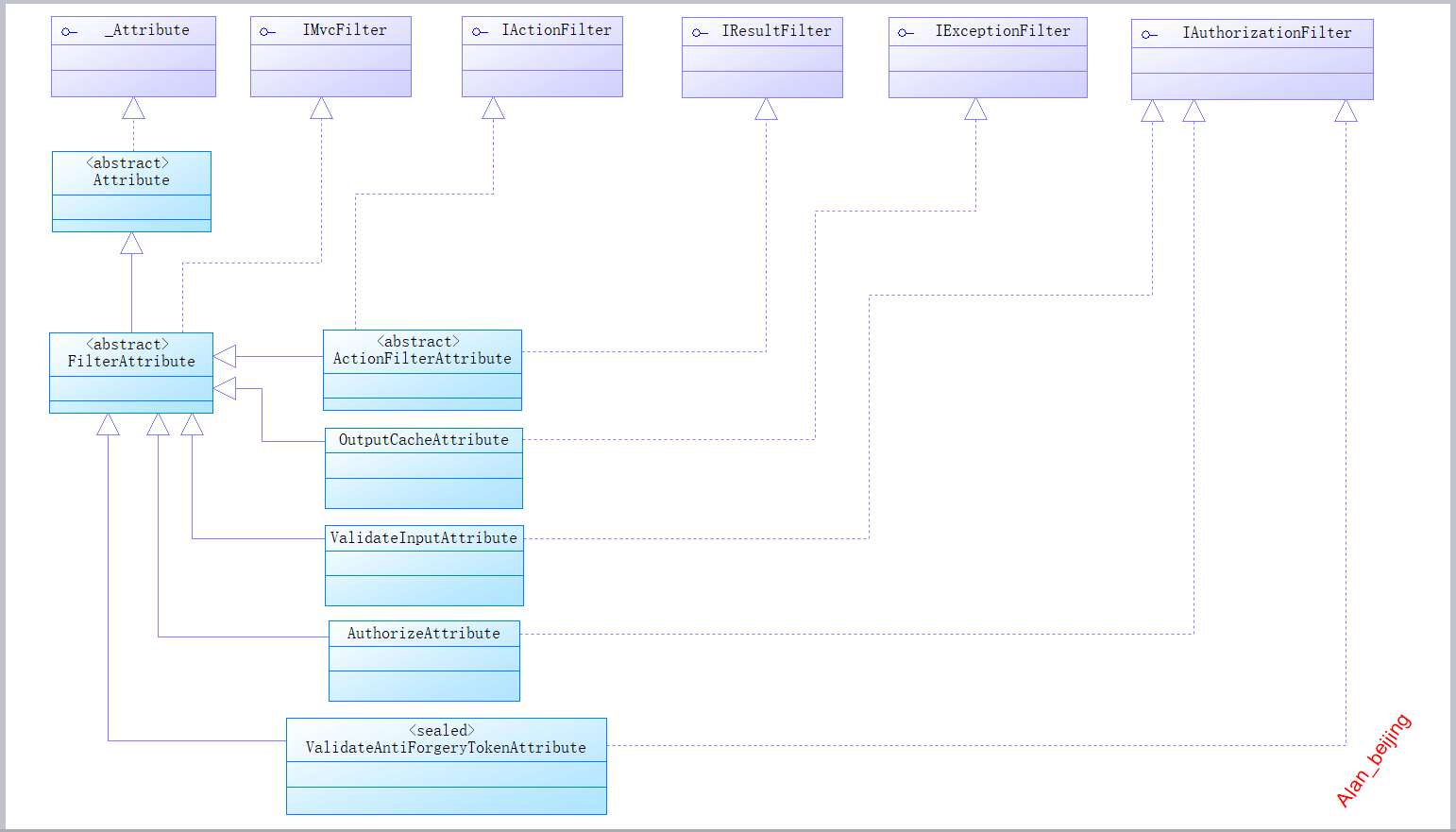
下麵,我們根據如上的UML圖來簡要分析一下。
(一)MVC基架過濾機制根介面
根介面:本文指在繼承關係中的根節點,相當於類的祖宗對象Object。
從上圖中,很容易看出MVC過濾機制的根介面主要有六大類型介面:_Attribute,IMvcFilter,IActionFilter,IResultFilter,IExceptionFilter和IAuthorizationFilter。
1._Attribute
_Attribute介面主要提供一些非托管服務。

2.IMvcFilter
該介面主要用於定義篩選器順序和是否允許多個篩選器,如當我們給某個action限定多個特性時的執行順序問題。
[Filter1(Order = 3)] [Filter2(Order = 2)] [Filter3(Order = 1)] public ActionResult Index() { return View(); ; }

3.IActionFilter
該介面主要定義操作的篩選,在執行操作方法前後,分別調用方法OnActionExecuting(ActionExecutingContext filterContext)和方法OnActionExecuted(ActionExecutedContext filterContext)。IResult也有類似兩個方法。
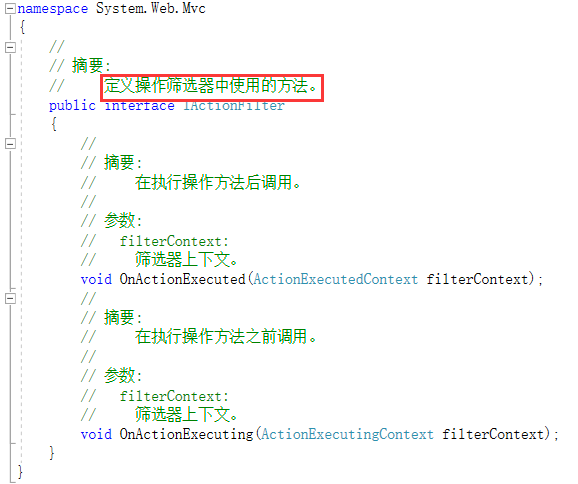
4.IResultFilter
該介面主要用作操作結果的篩選。對於MVC模式開發的程式員來說,ActionResult再熟悉不過了,然而,MVC機制會在操作結果執行前後,分別執行OnResultExecuting(ResultExecutingContext filterContext)方法和OnResultExecuted(ResultExecutedContext filterContext)方法,然後再將最終結果Responce給用戶,
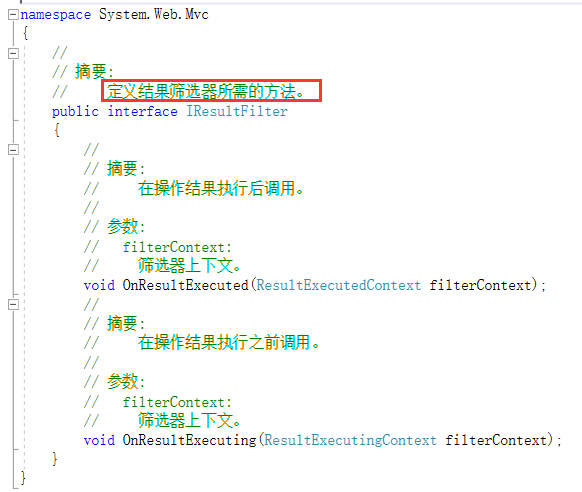
5.IExceptionFilter
該介面主要是用來處理系統異常問題,如在項目中經常用到的throw new Exception();
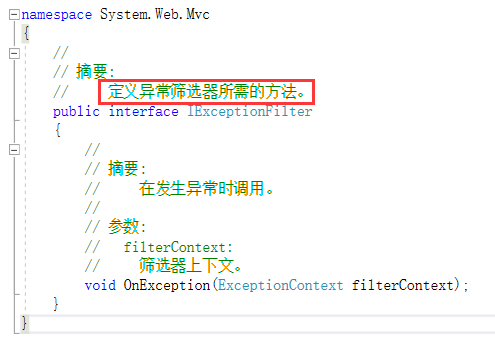
6.IAuthorizationFilter
該介面用來定義資源的篩選和授權,在項目中,主要用做許可權管理。
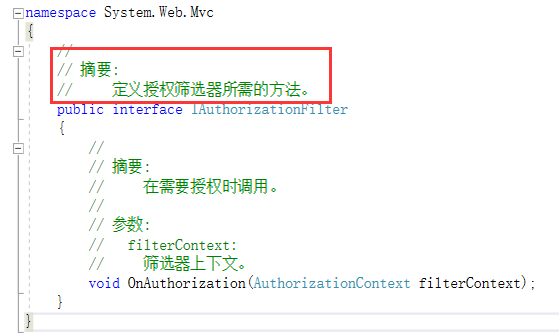
(二) 三個抽象介面
從上圖繼承圖中,不難看出,MVC過濾機制,提供了三個重要的抽象類,分別為:_Attribute,FilterAttribute和ActionFilterAttribute
1.ActionFilterAttribute
從繼承圖中知道,ActionFilterAttribute繼承FilterAttribute抽象類,實現IAcionFilter介面和IResultFilter介面。
反編譯代碼如下:
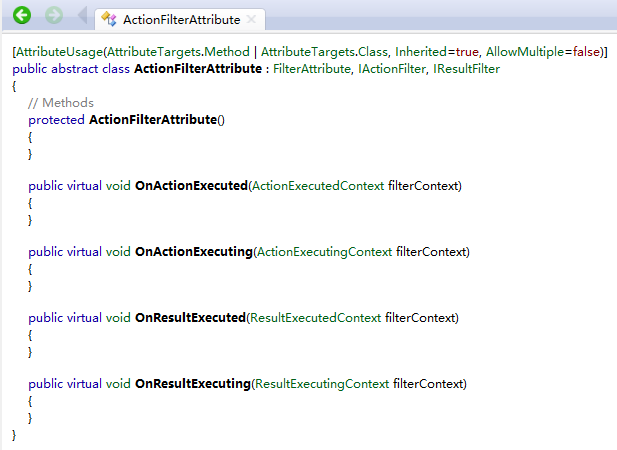
不難看出,ActionFilterAttribute共有四個虛方法和一個可被繼承構造函數,而四個虛方法,分別是IAcionFilter介面和IResultFilter方法簽名的原型。
四個虛方法,在上面我們已經分析過,這裡就不分析了,重點分析一下這四個方法的執行順序:
=》Request ip=>Route(路由器尋找具體Controller和action)=>執行action上面的特性=》OnActionExecutiong=》執行方法=》OnActionExecuted=》OnResultExecuting=》執行操作結果=》OnResultExecuted=》將執行結果最終Responce給瀏覽器。
源碼:
public class ExeOrderTestAttribute:ActionFilterAttribute { public override void OnActionExecuted(ActionExecutedContext filterContext) { Log("OnActionExecuted", filterContext.RouteData); base.OnActionExecuted(filterContext); } public override void OnActionExecuting(ActionExecutingContext filterContext) { Log("OnActionExecuting", filterContext.RouteData); base.OnActionExecuting(filterContext); } public override void OnResultExecuted(ResultExecutedContext filterContext) { Log("OnResultExecuted", filterContext.RouteData); base.OnResultExecuted(filterContext); } public override void OnResultExecuting(ResultExecutingContext filterContext) { Log("OnResultExecuting", filterContext.RouteData); base.OnResultExecuting(filterContext); } private void Log(string methodName, RouteData routeData) { var controllerName = routeData.Values["controller"]; var actionName = routeData.Values["action"]; var message = String.Format("{0} controller: {1} action: {2}", methodName, controllerName, actionName); Debug.WriteLine(message, "ASP.NET MVC Filter ExecuteOrder"); } }
(三)其他類
從上面的繼承圖中可以看出,ASP.NET MVC過濾機制,處理定義介面,抽象類外,還有一些其他基礎類,比較關鍵的類有:OutputCacheAttribute,ValidateInpuntAttribute,AuthorizeAttribute和ValidateAntiForgeryTokenAttribute。
1.OutputCacheAttribute
該類主要是解決Cache問題,感興趣的,可以看看淺談緩存技術在ASP.NET中的運用 ,這裡不累述。
2.ValidateInpuntAttribute 和ValidateAntiForgeryTokenAttribute
主要解決表單驗證問題,如防止漏洞註入,JS註入等問題。
3.AuthorizeAttribute
該類主要解決資源授權問題,也就是平時大家所說的許可權管等問題,是非常重要的一個類,因此將在本篇文章的第二部分單獨講解。
二 MVC框架授權機制
ASP.NET MVC框架通過AuthorizeAttribute類實現資源的許可權控制訪問。
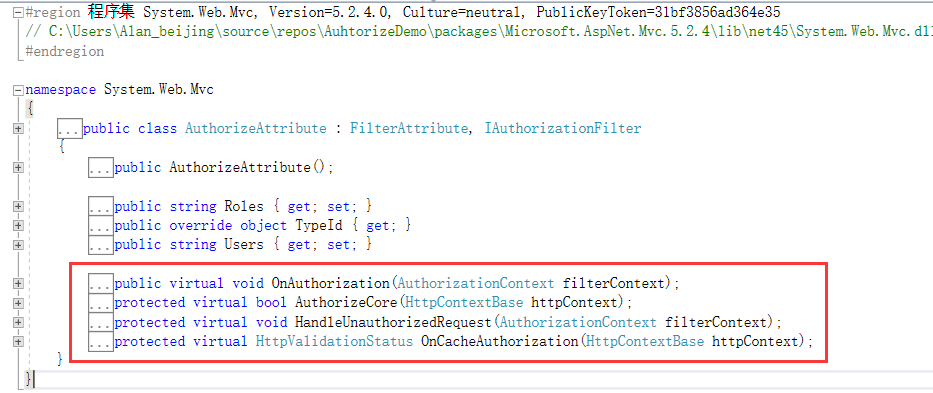
我們先來通過反彙編看看AuthorizeAttribute。

1 [AttributeUsage(AttributeTargets.Method | AttributeTargets.Class, Inherited=true, AllowMultiple=true)] 2 public class AuthorizeAttribute : FilterAttribute, IAuthorizationFilter 3 { 4 // Fields 5 private string _roles; 6 private string[] _rolesSplit = new string[0]; 7 private static readonly char[] _splitParameter = new char[] { ',' }; 8 private readonly object _typeId = new object(); 9 private string _users; 10 private string[] _usersSplit = new string[0]; 11 12 // Methods 13 protected virtual bool AuthorizeCore(HttpContextBase httpContext) 14 { 15 if (httpContext == null) 16 { 17 throw new ArgumentNullException("httpContext"); 18 } 19 IPrincipal user = httpContext.User; 20 if (!user.Identity.IsAuthenticated) 21 { 22 return false; 23 } 24 if ((this._usersSplit.Length != 0) && !this._usersSplit.Contains<string>(user.Identity.Name, StringComparer.OrdinalIgnoreCase)) 25 { 26 return false; 27 } 28 if ((this._rolesSplit.Length != 0) && !this._rolesSplit.Any<string>(new Func<string, bool>(user.IsInRole))) 29 { 30 return false; 31 } 32 return true; 33 } 34 35 private void CacheValidateHandler(HttpContext context, object data, ref HttpValidationStatus validationStatus) 36 { 37 validationStatus = this.OnCacheAuthorization(new HttpContextWrapper(context)); 38 } 39 40 protected virtual void HandleUnauthorizedRequest(AuthorizationContext filterContext) 41 { 42 filterContext.Result = new HttpUnauthorizedResult(); 43 } 44 45 public virtual void OnAuthorization(AuthorizationContext filterContext) 46 { 47 if (filterContext == null) 48 { 49 throw new ArgumentNullException("filterContext"); 50 } 51 if (OutputCacheAttribute.IsChildActionCacheActive(filterContext)) 52 { 53 throw new InvalidOperationException(MvcResources.AuthorizeAttribute_CannotUseWithinChildActionCache); 54 } 55 if (!filterContext.ActionDescriptor.IsDefined(typeof(AllowAnonymousAttribute), true) && !filterContext.ActionDescriptor.ControllerDescriptor.IsDefined(typeof(AllowAnonymousAttribute), true)) 56 { 57 if (this.AuthorizeCore(filterContext.HttpContext)) 58 { 59 HttpCachePolicyBase cache = filterContext.HttpContext.Response.Cache; 60 cache.SetProxyMaxAge(new TimeSpan(0L)); 61 cache.AddValidationCallback(new HttpCacheValidateHandler(this.CacheValidateHandler), null); 62 } 63 else 64 { 65 this.HandleUnauthorizedRequest(filterContext); 66 } 67 } 68 } 69 70 protected virtual HttpValidationStatus OnCacheAuthorization(HttpContextBase httpContext) 71 { 72 if (httpContext == null) 73 { 74 throw new ArgumentNullException("httpContext"); 75 } 76 if (!this.AuthorizeCore(httpContext)) 77 { 78 return HttpValidationStatus.IgnoreThisRequest; 79 } 80 return HttpValidationStatus.Valid; 81 } 82 83 internal static string[] SplitString(string original) 84 { 85 if (string.IsNullOrEmpty(original)) 86 { 87 return new string[0]; 88 } 89 return original.Split(_splitParameter).Select((<>c.<>9__19_0 ?? (<>c.<>9__19_0 = new Func<string, <>f__AnonymousType1<string, string>>(<>c.<>9.<SplitString>b__19_0)))).Where((<>c.<>9__19_1 ?? (<>c.<>9__19_1 = new Func<<>f__AnonymousType1<string, string>, bool>(<>c.<>9.<SplitString>b__19_1)))).Select((<>c.<>9__19_2 ?? (<>c.<>9__19_2 = new Func<<>f__AnonymousType1<string, string>, string>(<>c.<>9.<SplitString>b__19_2)))).ToArray<string>(); 90 } 91 92 // Properties 93 public string Roles 94 { 95 get 96 { 97 return (this._roles ?? string.Empty); 98 } 99 set 100 { 101 this._roles = value; 102 this._rolesSplit = SplitString(value); 103 } 104 } 105 106 public override object TypeId 107 { 108 get 109 { 110 return this._typeId; 111 } 112 } 113 114 public string Users 115 { 116 get 117 { 118 return (this._users ?? string.Empty); 119 } 120 set 121 { 122 this._users = value; 123 this._usersSplit = SplitString(value); 124 } 125 } 126 127 // Nested Types 128 [Serializable, CompilerGenerated] 129 private sealed class <>c 130 { 131 // Fields 132 public static readonly AuthorizeAttribute.<>c <>9 = new AuthorizeAttribute.<>c(); 133 public static Func<string, <>f__AnonymousType1<string, string>> <>9__19_0; 134 public static Func<<>f__AnonymousType1<string, string>, bool> <>9__19_1; 135 public static Func<<>f__AnonymousType1<string, string>, string> <>9__19_2; 136 137 // Methods 138 internal <>f__AnonymousType1<string, string> <SplitString>b__19_0(string piece) 139 { 140 return new { piece = piece, trimmed = piece.Trim() }; 141 } 142 143 internal bool <SplitString>b__19_1(<>f__AnonymousType1<string, string> <>h__TransparentIdentifier0) 144 { 145 return !string.IsNullOrEmpty(<>h__TransparentIdentifier0.trimmed); 146 } 147 148 internal string <SplitString>b__19_2(<>f__AnonymousType1<string, string> <>h__TransparentIdentifier0) 149 { 150 return <>h__TransparentIdentifier0.trimmed; 151 } 152 } 153 } 154 155 156 Collapse Methods 157View Code
通過反彙編,得出如下結論:
1.提供四個虛方法OnAuthorization(AuthorizationContext filterContext),AuthorizeCore(HttpContextBase httpContext),HandleUnauthorizedRequest(AuthorizationContext filterContext)和OnCacheAuthorization(HttpContextBase httpContext)。
四個方法作用和關係是怎樣的呢
OnAuthorization表示請求過程時身份驗證,AuthorizeCore表示支持用戶自定義身份驗證,HandleUnauthorizeRequest表示當AuthorizeCore方法驗證失敗時,執行的操作,OnCacheAuthorization表示模塊緩存許可權。
(一) ASP.NET MVC 基架提供的驗證
只需在需要驗證的資源生加上[Authorize]特性即可。
1 [Authorize] 2 public ActionResult Index() 3 { 4 return View(); ; 5 }
(二) 實現自定義驗證機制
當未給Index() action添加驗證限制時,匿名用戶名能直接訪問 /Default/Index

當給Index() action添加驗證限制時,匿名用戶名不能直接訪問 /Default/Index,而被強制重定型到登陸頁面,要求用戶登陸。

(三) ASP.NET MVC驗證級別
ASP.NET MVC提供了四種基本驗證模式:匿名,全局,控制器和Action
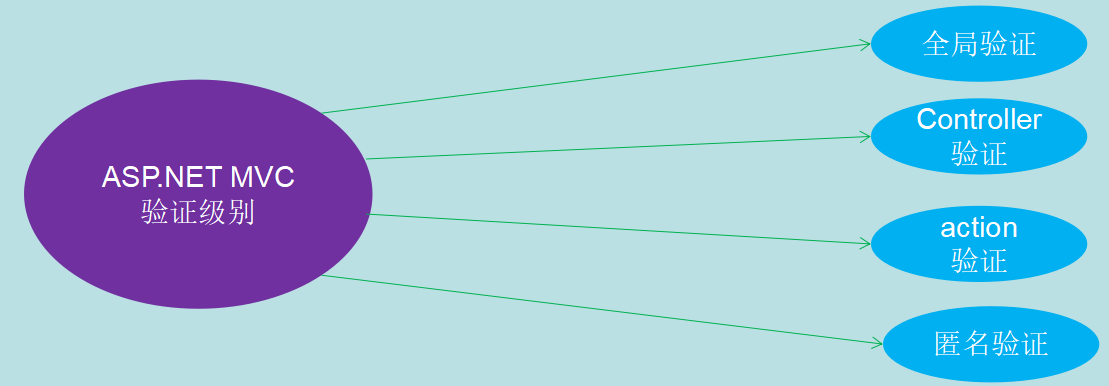
1.匿名
1 public class DefaultController : Controller 2 { 3 [AllowAnonymous] 4 public ActionResult Index() 5 { 6 return View(); 7 } 8 }
2.action
1 public class DefaultController : Controller 2 { 3 [CustomAuthorize] 4 public ActionResult Index() 5 { 6 return View(); 7 } 8 }
3.Controller
1 [CustomAuthorize] 2 public class DefaultController : Controller 3 { 4 public ActionResult Index() 5 { 6 return View(); 7 } 8 }
4.全局
1 public class FilterConfig 2 { 3 public static void RegisterGlobalFilters(GlobalFilterCollection filters) 4 { 5 filters.Add(new CustomAuthorizeAttribute());//給自定義驗證註冊 6 filters.Add(new HandleErrorAttribute()); 7 } 8 }
擴展,當添加多個驗證時,程式時如何執行的?通古Order值順序執行
1 [Filter1(Order = 3)] 2 [Filter2(Order = 2)] 3 [Filter3(Order = 1)] 4 public ActionResult Index() 5 { 6 return View(); ; 7 }
三 總結
本篇文章主要從ASP.NET MVC框架設計角度,運用PD工具,通過UML分析ASP.NET MVC是如何實現資源過濾,如何實現許可權控制等功能的,更細粒度的技術文章,在後續博文中更新。




